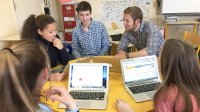Real-World Applications of Classroom Learning
Project-based learning ideas that have your students collaborate with peers around the world and apply their learning to make a difference.
Your content has been saved!
Go to My Saved Content.Instead of promising students that today’s lessons will be important in their lives someday, why not help them apply what they’re learning to tackle real issues now? “Education without action is like food without exercise,” says veteran educator Terry Godwaldt, founder of the Centre for Global Education in Edmonton, Alberta.
Without meaningful opportunities to put problem-solving skills to work, Godwaldt cautions, students may gradually lose hope that they can make a difference. “Maybe in first grade they hear about the plight of polar bears. That opens a wound. Later it’s climate change, and the wound gets bigger. Eventually,” he warns, “young people learn to change the channel [mentally] when they hear about issues they don’t think they can affect.”
To prevent that slide into apathy, Godwaldt teams up with partners to design global collaborative projects that emphasize action along with inquiry. During the coming school year, he aims to engage 100,000 students in a project called #Decarbonize, focusing on youth response to climate change. The project offers multiple ways for students to engage, including a virtual art gallery to illustrate how climate change is affecting Earth’s indigenous populations. Students are getting ready to take action during the U.N. Climate Change Conference in Bonn, Germany.
3 More Projects That Inspire Action
Since meeting Godwaldt during Global Education Day at the 2017 International Society for Technology in Education conference, I’ve been keeping an eye out for more project ideas to help students take part in real-world learning. Here are three suggestions for the coming school year.
1. The Sustainable Development Goals (SDGs): The 17 Global Goals for Sustainable Development established by the U.N. focus on issues ranging from clean water and sanitation to peace and justice. For educators, the SDGs offer a framework for designing authentic project-based learning experiences that connect students with today’s most pressing issues.
A growing movement to teach the SDGs across the curriculum is generating new resources for teachers, including Twitter chats (#TeachSDGs) and online courses from Participate, and Microsoft Skype offers a matching platform to connect educators on collaborative projects about the SDGs. What might teaching the SDGs look like? New York teacher Amy Rosenstein had her second graders apply communication skills to create digital posters to educate others about the SDGs, then used Skype to talk about them with children from around the world.
For high school teacher Jason Welker, the SDGs offered a way to teach environmental economics via project-based learning. His students at Zurich International School applied economic theories to address the goals they wanted to affect, leading up to action projects of their own design.
2. The Monuments Project: Giving students as young as middle school opportunities to do the real work of historians—and provide meaningful public service in the process—is the idea behind the Monuments Project. Participating students collaborate across time zones and even oceans to research and tell the stories of World War I veterans buried in American cemeteries abroad.
Teacher Tom Neville of the American School of Paris launched the project over the 2016–17 school year to have his students discover the untold stories of WWI veterans buried in Suresnes American Cemetery outside Paris. Realizing that they needed access to primary source materials in the U.S., Neville and his students teamed up with social studies teacher Anthony Rovente and his students at Lopez Island Middle School in Washington State.
The project has continued to grow with more schools and independent researchers joining from New York, West Virginia, and elsewhere. To encourage broader participation, Neville has shared an online briefcase loaded with digital tools, databases for research, and more.
3. The Future of Food: In July, I took part in a Global Leadership Summit organized by EF Education First on the Future of Food. Some 2,000 high school students and teachers gathered in Milan, Italy, to think creatively and collaboratively about how to improve access to fresh, healthy, affordable food for our ever-growing species. While students dove into a design thinking challenge about actions they might take, I brainstormed with teachers about academically rigorous project ideas that focus on food—growing it, cooking it, sharing it, writing about it, and marketing it in a way that’s equitable and sustainable.
Here are a few of the driving questions and content connections that emerged:
- How can we make better food choices to reduce our impact on the environment? (Content connections: math, geography, science, health)
- How can our stories change our eating habits and empower healthier communities? (Content connections: language arts, health, social studies)
- How can we prevent language barriers from preventing access to information on health and well-being? (Content connections: world languages, English, health)
